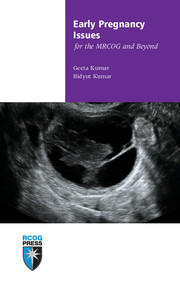Book contents
- Frontmatter
- Contents
- Dedication and acknowledgement
- About the authors
- Abbreviations
- Preface
- 1 Embryogenesis and physiology
- 2 Miscarriage
- 3 Recurrent miscarriage
- 4 Ectopic pregnancy
- 5 Trophoblastic disease
- 6 Hyperemesis gravidarum
- 7 Abdominal and pelvic pain in early pregnancy
- 8 Prescribing issues
- 9 Ultrasound and screening
- Further reading
- Index
- Published titles in the MRCOG and Beyond series
6 - Hyperemesis gravidarum
Published online by Cambridge University Press: 05 July 2014
- Frontmatter
- Contents
- Dedication and acknowledgement
- About the authors
- Abbreviations
- Preface
- 1 Embryogenesis and physiology
- 2 Miscarriage
- 3 Recurrent miscarriage
- 4 Ectopic pregnancy
- 5 Trophoblastic disease
- 6 Hyperemesis gravidarum
- 7 Abdominal and pelvic pain in early pregnancy
- 8 Prescribing issues
- 9 Ultrasound and screening
- Further reading
- Index
- Published titles in the MRCOG and Beyond series
Summary
Nausea and vomiting are very common in pregnancy and affect up to 85% of pregnant women. Although commonly known as ‘morning sickness’ very few women experience nausea solely in the morning and majority (80%) report nausea throughout the day. The condition is usually mild and self-limiting and usually resolves by 14 weeks of gestation. Hyperemesis gravidarum, however, is unexplained intractable form of nausea and vomiting in pregnancy leading to fluid, electrolyte imbalance and weight loss. This condition affects 0.3–2.0% of pregnant women and is one of the most common reasons for hospitalisation in the first trimester of pregnancy. The Confidential Enquiries into Maternal Deaths in the United Kingdom 1991–1993 reported three maternal deaths related to hyperemesis. Fortunately, there has been no recorded mortality attributable to hyperemesis gravidarum in the two most recent reports.
Diagnosis
Hyperemesis gravidarum is often diagnosed subjectively based on the symptoms of severe nausea and vomiting leading to dehydration, fluid and electrolyte imbalance, nutritional deficiency and often necessitating hospitalisation. While a criterion of weight loss of more than 5% of prepregnancy weight has been used as a standard for diagnosis, the Fairweather criteria define hyperemesis gravidarum as more than three episodes of vomiting in a day with weight loss, ketonaemia, electrolyte imbalance and volume depletion, with onset usually at 4–8 weeks of pregnancy. According to the International Classification of Diseases (ICD-10), hyperemesis gravidarum is defined as persistent and excessive vomiting with onset before 22 completed weeks of gestation and is subclassified as mild and severe (Table 6.1).
- Type
- Chapter
- Information
- Early Pregnancy Issues for the MRCOG and Beyond , pp. 73 - 80Publisher: Cambridge University PressPrint publication year: 2011

